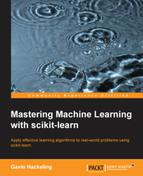In this example, we will combine clustering with classification in a semi-supervised learning problem. You will learn features by clustering unlabeled data and use the learned features to build a supervised classifier.
Suppose you own a cat and a dog. Suppose that you have purchased a smartphone, ostensibly to use to communicate with humans, but in practice just to use to photograph your cat and dog. Your photographs are awesome and you are certain that your friends and co-workers would love to review all of them in detail. You'd like to be courteous and respect that some people will only want to see your cat photos, while others will only want to see your dog photos, but separating the photos is laborious. Let's build a semi-supervised learning system that can classify images of cats and dogs.
Recall from Chapter 3, Feature Extraction and Preprocessing, that a naïve approach to classifying images is to use the intensities, or brightnesses, of all of the pixels as explanatory variables. This approach produces high-dimensional feature vectors for even small images. Unlike the high-dimensional feature vectors we used to represent documents, these vectors are not sparse. Furthermore, it is obvious that this approach is sensitive to the image's illumination, scale, and orientation. In Chapter 3, Feature Extraction and Preprocessing, we also discussed SIFT and SURF descriptors, which describe interesting regions of an image in ways that are invariant to scale, rotation, and illumination. In this example, we will cluster the descriptors extracted from all of the images to learn features. We will then represent an image with a vector with one element for each cluster. Each element will encode the number of descriptors extracted from the image that were assigned to the cluster. This approach is sometimes called the bag-of-features representation, as the collection of clusters is analogous to the bag-of-words representation's vocabulary. We will use 1,000 images of cats and 1,000 images of dogs from the training set for Kaggle's Dogs vs. Cats competition. The dataset can be downloaded from https://www.kaggle.com/c/dogs-vs-cats/data. We will label cats as the positive class and dogs as the negative class. Note that the images have different dimensions; since our feature vectors do not represent pixels, we do not need to resize the images to have the same dimensions. We will train using the first 60 percent of the images, and test on the remaining 40 percent:
>>> import numpy as np >>> import mahotas as mh >>> from mahotas.features import surf >>> from sklearn.linear_model import LogisticRegression >>> from sklearn.metrics import * >>> from sklearn.cluster import MiniBatchKMeans >>> import glob
First, we load the images, convert them to grayscale, and extract the SURF descriptors. SURF descriptors can be extracted more quickly than many similar features, but extracting descriptors from 2,000 images is still computationally expensive. Unlike the previous examples, this script requires several minutes to execute on most computers:
>>> all_instance_filenames = []
>>> all_instance_targets = []
>>> for f in glob.glob('cats-and-dogs-img/*.jpg'):
>>> target = 1 if 'cat' in f else 0
>>> all_instance_filenames.append(f)
>>> all_instance_targets.append(target)
>>> surf_features = []
>>> counter = 0
>>> for f in all_instance_filenames:
>>> print 'Reading image:', f
>>> image = mh.imread(f, as_grey=True)
>>> surf_features.append(surf.surf(image)[:, 5:])
>>> train_len = int(len(all_instance_filenames) * .60)
>>> X_train_surf_features = np.concatenate(surf_features[:train_len])
>>> X_test_surf_feautres = np.concatenate(surf_features[train_len:])
>>> y_train = all_instance_targets[:train_len]
>>> y_test = all_instance_targets[train_len:]We then group the extracted descriptors into 300 clusters in the following code sample. We use MiniBatchKMeans, a variation of K-Means that uses a random sample of the instances in each iteration. As it computes the distances to the centroids for only a sample of the instances in each iteration, MiniBatchKMeans converges more quickly but its clusters' distortions may be greater. In practice, the results are similar, and this compromise is acceptable.:
>>> n_clusters = 300 >>> print 'Clustering', len(X_train_surf_features), 'features' >>> estimator = MiniBatchKMeans(n_clusters=n_clusters) >>> estimator.fit_transform(X_train_surf_features)
Next, we construct feature vectors for the training and testing data. We find the cluster associated with each of the extracted SURF descriptors, and count them using NumPy's binCount() function. The following code produces a 300-dimensional feature vector for each instance:
>>> X_train = [] >>> for instance in surf_features[:train_len]: >>> clusters = estimator.predict(instance) >>> features = np.bincount(clusters) >>> if len(features) < n_clusters: >>> features = np.append(features, np.zeros((1, n_clusters-len(features)))) >>> X_train.append(features) >>> X_test = [] >>> for instance in surf_features[train_len:]: >>> clusters = estimator.predict(instance) >>> features = np.bincount(clusters) >>> if len(features) < n_clusters: >>> features = np.append(features, np.zeros((1, n_clusters-len(features)))) >>> X_test.append(features)
Finally, we train a logistic regression classifier on the feature vectors and targets, and assess its precision, recall, and accuracy:
>>> clf = LogisticRegression(C=0.001, penalty='l2')
>>> clf.fit_transform(X_train, y_train)
>>> predictions = clf.predict(X_test)
>>> print classification_report(y_test, predictions)
>>> print 'Precision: ', precision_score(y_test, predictions)
>>> print 'Recall: ', recall_score(y_test, predictions)
>>> print 'Accuracy: ', accuracy_score(y_test, predictions)
Reading image: dog.9344.jpg
...
Reading image: dog.8892.jpg
Clustering 756914 features
precision recall f1-score support
0 0.71 0.76 0.73 392
1 0.75 0.70 0.72 408
avg / total 0.73 0.73 0.73 800
Precision: 0.751322751323
Recall: 0.696078431373
Accuracy: 0.7275This semi-supervised system has better precision and recall than a logistic regression classifier that uses only the pixel intensities as features. Furthermore, our feature representations have only 300 dimensions; even small 100 x 100 pixel images would have 10,000 dimensions.
